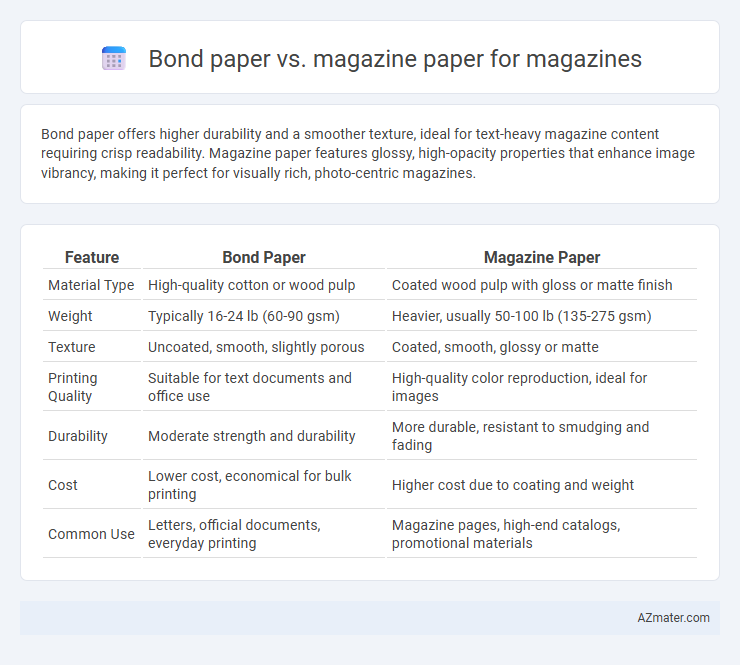Bond paper offers higher durability and a smoother texture, ideal for text-heavy magazine content requiring crisp readability. Magazine paper features glossy, high-opacity properties that enhance image vibrancy, making it perfect for visually rich, photo-centric magazines.
Table of Comparison
| Feature | Bond Paper | Magazine Paper |
|---|---|---|
| Material Type | High-quality cotton or wood pulp | Coated wood pulp with gloss or matte finish |
| Weight | Typically 16-24 lb (60-90 gsm) | Heavier, usually 50-100 lb (135-275 gsm) |
| Texture | Uncoated, smooth, slightly porous | Coated, smooth, glossy or matte |
| Printing Quality | Suitable for text documents and office use | High-quality color reproduction, ideal for images |
| Durability | Moderate strength and durability | More durable, resistant to smudging and fading |
| Cost | Lower cost, economical for bulk printing | Higher cost due to coating and weight |
| Common Use | Letters, official documents, everyday printing | Magazine pages, high-end catalogs, promotional materials |
Introduction to Paper Types in Magazine Publishing
Bond paper offers durability and smooth texture suitable for text-heavy magazine sections, enhancing readability and professional appearance. Magazine paper, typically coated and glossy, delivers vibrant color reproduction and sharp image quality essential for visual storytelling and advertising content. Selecting the appropriate paper type directly impacts print quality, audience engagement, and production costs in magazine publishing.
What is Bond Paper?
Bond paper is a high-quality, durable paper commonly used for letterheads, stationery, and official documents, characterized by its strong fiber composition that provides excellent strength and tear resistance. It typically has a smooth finish and a weight ranging from 16 to 36 pounds, making it suitable for printing crisp text and detailed images. In contrast to magazine paper, which is glossy and optimized for vibrant color reproduction, bond paper emphasizes durability and clarity, often used for internal documents or inserts within magazines rather than the main publication pages.
What is Magazine Paper?
Magazine paper is a type of coated, glossy paper designed to enhance color vibrancy and image sharpness, making it ideal for high-quality magazine printing. Unlike bond paper, which has a rougher texture and is primarily used for everyday printing and office documents, magazine paper provides a smooth finish that improves ink absorption and visual appeal. This specialized paper often features a heavier weight and higher brightness, ensuring durability and professional presentation in printed magazines.
Physical Differences: Texture, Weight, and Finish
Bond paper features a smooth texture, lighter weight typically around 16-24 lb, and a matte finish suitable for text-heavy content, providing easy readability. Magazine paper is heavier, often 48-100 lb, with a glossy or semi-gloss finish that enhances image vibrancy and color saturation, ideal for visual appeal. The tactile contrast lies in bond paper's firmness and matte surface versus magazine paper's slick, polished feel that supports high-resolution photographs.
Print Quality: Color Vibrancy and Image Clarity
Magazine paper offers superior print quality with enhanced color vibrancy and exceptional image clarity due to its smooth, coated surface designed to hold ink precisely. Bond paper, often uncoated and more absorbent, results in duller colors and less sharp images, making it less ideal for high-quality magazine printing. For vivid visuals and crisp details, magazine paper remains the preferred choice in professional magazine production.
Durability and Longevity Comparison
Bond paper offers superior durability compared to magazine paper, thanks to its higher fiber content and density, which enhances tear resistance and longevity. Magazine paper, often coated and lightweight, provides vibrant color reproduction but tends to yellow and become brittle over time due to lower-quality pulp and high-speed printing processes. For magazines requiring extended shelf life and frequent handling, bond paper is a better choice, while magazine paper suits short-term, visually dynamic publications.
Cost Analysis: Bond Paper vs Magazine Paper
Bond paper generally costs less per sheet than magazine paper, making it a budget-friendly option for large print runs. Magazine paper, often glossy and coated, incurs higher production costs due to its quality features that enhance color vibrancy and durability. Evaluating these expenses helps publishers balance the trade-off between upfront printing costs and the perceived value of the final magazine product.
Environmental Impact and Sustainability
Bond paper generally has a higher environmental impact than magazine paper due to its production process, which typically involves more energy and chemicals. Magazine paper often uses recycled fibers and is engineered for lower weight, reducing resource consumption and transportation emissions. Opting for magazine paper over bond paper enhances sustainability by minimizing deforestation and promoting recycling practices in print media.
Best Applications: When to Use Each Paper Type
Bond paper is ideal for magazines that require crisp text clarity, durability, and affordability, making it suitable for newsletters, reports, or magazines with heavy text content. Magazine paper, often coated and glossy, enhances vibrant image reproduction and color accuracy, perfect for fashion, lifestyle, and art magazines where visual appeal is critical. Choosing bond paper optimizes readability and cost-efficiency, while magazine paper excels in delivering high-quality visuals and a premium tactile experience.
Conclusion: Choosing the Right Paper for Your Magazine
Selecting the right paper for your magazine significantly impacts print quality, durability, and reader experience. Bond paper offers affordability and smooth texture but lacks the vibrant color reproduction and glossiness of magazine paper, which is designed for high-quality images and a professional finish. Prioritize magazine paper for visually rich content and brand prestige, while bond paper suits budget-conscious, text-heavy publications.

Infographic: Bond paper vs Magazine paper for Magazine
 azmater.com
azmater.com